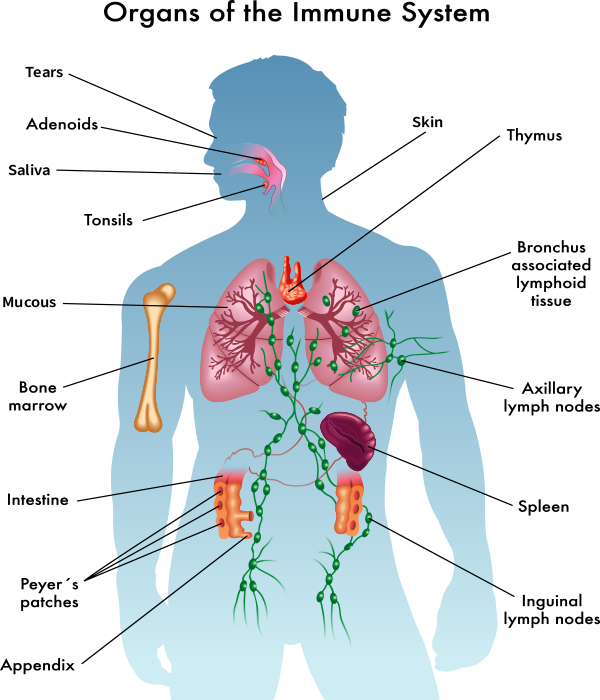What is The Immune System? (SCT)

![]() If you'd like to have someone read this section for you, click play below.
If you'd like to have someone read this section for you, click play below.
The immune system (from the Latin word immunis, meaning: "free" or "untouched") is the body’s defense system. It is made up of a network of cells, tissues and organs that all work together to protect us against pathogens (disease-causing microorganisms, such as viruses, bacteria, parasites and fungi). Pathogens cause infection when they enter the body and begin to multiply. Disease occurs when your body’s cells are damaged because of the infection. Then signs and symptoms of illness appear.
Cells, organs and tissues of the immune system
The cells, organs and tissues of the immune system are located throughout the body, allowing for a quick response to infection. Study the image below from the Vaccine Makers Project to learn what organs and tissues are part of the immune system and where they are located.

White blood cells (also called leukocytes) are the cells of the immune system. They are responsible for protecting the body against pathogens. They are produced in the bone marrow and stored in several locations throughout the body, including the thymus, spleen and lymph nodes. They travel throughout the body via the bloodstream and in specialized vessels called lymphatic vessels.
There are several types of white blood cells, all with specific functions. Examples include phagocytes (like macrophages) that roam the body looking for any foreign invaders to destroy and lymphocytes (B cells and T cells) that are set into action in response to a specific pathogen such as a virus or bacterium. When a pathogen is detected the different types of white blood cells work together to recognize it and respond, protecting the body from disease.
The immune system has two main parts: Innate and Adaptive
The immune system has two main parts, the innate immune system and the adaptive immune system.
The Innate Immune System
The innate immune system is our body’s first line of defense against pathogens. It is a generalized, non-specific defense system (meaning that the defenses protect against all pathogens).
The innate immune system defenses consist of the protective mechanisms we are born with (innate means “inborn” or “natural”). These include physical barriers like our skin and mucous membranes, chemical barriers like saliva and stomach acid, immune system cells like macrophages that are constantly on the lookout for pathogens to destroy, proteins like cytokines (chemical messengers that immune cells use to communicate with one another), and the inflammatory response (inflammation). In most cases the innate immune defenses are enough to fight off pathogens before they can cause an infection but when they aren’t, the adaptive immune system is called into action (the adaptive immune system is covered in the next lesson).
Watch the video from Crash Course to learn more about the innate immune system (the video below will only show you the best parts, but feel free to watch the whole thing if you'd like!).
![]() If you'd like to have someone read this section for you, click play below.
If you'd like to have someone read this section for you, click play below.
The Adaptive Immune System
The adaptive immune system (adaptive meaning it can adapt to a specific threat) is the body’s second line of defense against pathogens. It is a specific defense system (meaning that its defense mechanisms directly target a specific pathogen) that is called into action when innate defenses are overcome. The specificity of the adaptive immune system comes from its ability to recognize a pathogen by its antigens. Antigens are molecular structures, such as proteins or polysaccharides (complex sugars) found on the surface of a pathogen, that are able to trigger the immune system to respond.
The main cells of the adaptive immune system are B cells and T cells. If a pathogen invades the body, it is detected by an antigen-presenting cell, such as a dendritic cell. These cells display antigens from the pathogen on their cell surface and travel to the lymph nodes where they present the antigen to T cells, activating them. These T cells then activate B cells to produce Y-shaped proteins called antibodies that attach to the pathogen and either neutralize it (by preventing it from entering other cells), or tag it for other immune cells to destroy. Other T cells are able to destroy cells that have already been infected. Some T cells and B cells become memory cells that protect against infection in the future. If the same pathogen invades the body again, these cells remember it and respond quickly and efficiently, preventing infection. This protection is called immunity.
Watch the video from Crash Course to learn more about the adaptive immune system (the video below will only show you the best parts, but feel free to watch the whole thing if you'd like!).
All lessons & quizzes are free!
This was just one of the lessons in our Immune System, How Vaccines Work, & The COVID-19 Vaccine section. There are over 30 lessons on Kids Boost Immunity just like this one on a variety of subjects. Each lesson includes a quiz, and every time a student scores 80% or higher on a quiz, we will donate life-saving vaccines to UNICEF UK. Sign up now!





